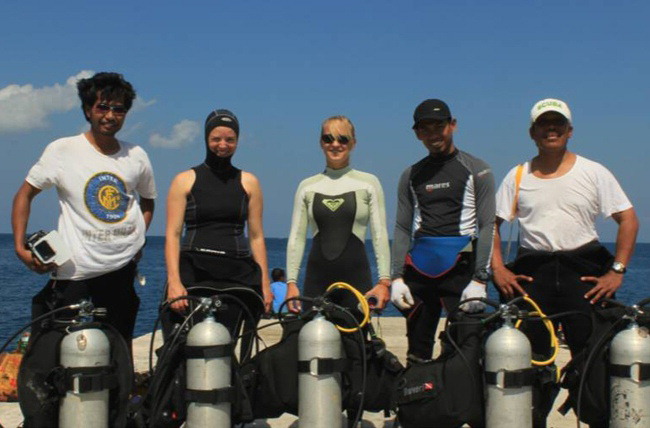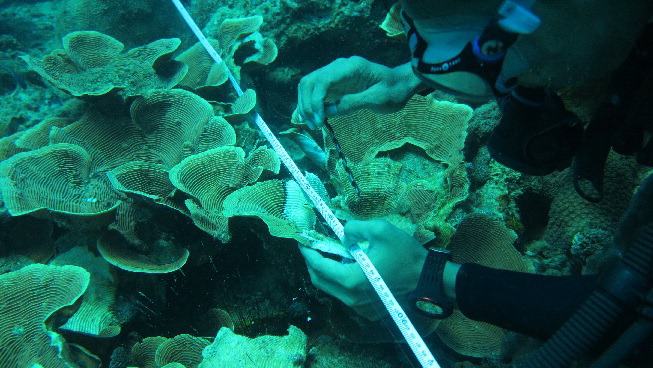|
Cycle 1 (2011 Deadline)
Coral health surveys in COREMAP: building resilience in climate-impacted coral reefs of Indonesia PI: Jamaluddin Jompa, Hasanuddin University U.S. Partner: C. Drew Harvell, Cornell University Project Dates: June 2012 - April 2015 Project Overview Marine protected areas (no-fish reserves) are the primary mechanism to preserve coral-reef ecosystems and the ecosystem services they provide to coastal communities. However, the ability for marine protected areas to reduce one of the most detrimental impacts to coral reefs, coral disease, is unknown. Coral diseases are often related to colony density and therefore may be more common in protected areas that have high coral cover. Reduced fishing practices within protected areas leads to a more functionally diverse fish community. Herbivorous fishes may reduce algal cover, a potential vector for coral disease transmission, while piscivorous fishes may reduce the populations of corallivores that may spread diseases to corals. This project aims to test the hypothesis that marine protected areas will improve resilience of coral communities and, in particular, reduce the prevalence of coral disease. Since it began in 1998, the Indonesian Coral Reef Rehabilitation and Management Program (COREMAP), has created different marine protected areas within the country. COREMAP is a long-term program aimed at protecting, rehabilitating, and achieving sustainable use of the Indonesian coral reefs. COREMAP's efforts include training for scientists to properly identify coral diseases.
The PEER-supported project surveyed three locations within selected COREMAP protected areas as well as adjacent unprotected areas that are ecologically similar to its paired site. Each site was surveyed using a nested approach to account for spatial variations and differences in depth profile. By bringing the complementary skills and expertise of the Indonesian and U.S. researchers to bear, this project evaluated the impact of coral diseases throughout Indonesia, the most coral-diverse region in the world, and helped quantify the efficacy of marine protected areas in reducing coral disease outbreaks.
Final Summary of Project Activities The PI and his team conducted coral disease survey work, including sample collection (mucus) and water quality sampling off Badi, Bonetambung, and Barranglompo Islands; turf algae growth rate monitoring in the Spermonde Archipelago; and surveys of coral diseases and coral cover at Mentawai Sumatra. The research team produced two videos highlighting their project and its impacts. One video is intended for general audiences and the other includes additional lecture footage appropriate for students. Findings and photographs from their research have been included in the materials of several courses such as Coralogy, Microbiology, and Marine at the Faculty of Marine Science and Fisheries.
The PEER grantees created the Coral Diseases Working Group (CDWG), established to exchange ideas and distribute information with all scientists who have interest or experiences on coral diseases. During the PEER project, researchers met with USAID staff and took them to the field to witness the coral diseases under water. They also presented the results to governmental and community groups at workshops, and have communicated with the tourism industry in Bali to encourage them to avoid further degradation of coral reefs around the island, which is one of the most important destinations for international tourists.
Leaflets and posters on coral diseases and actions to prevent them were distributed to COREMAP sites nationwide, and the PEER researchers presented their results at conferences, including the Annual Meeting of Indonesian Association of Oceanologists, World Coral Reef Conference, and the National Symposium on Marine Science and Fisheries.

| 
| | Indonesian and U.S. project participants prepare for another survey dive (photo courtesy of Dr. Jompa) | A project member measures tags and samples coral for black band disease (photo courtesy of Dr. Jompa) . |
PublicationsRahmi, B. Hamdani, Arniati, and J. Jompa. 2014. Identifikasi Penyakit pada Karang Keras (Scleractinia) di Pulau Barrang Lompo. Edt. Kartono D.T.,Surata, S.P.K., Arnawa, K. Prosiding SEMNAS 2014 Hasil-Hasil Penelitian. UNMAS Press. ISBN 978-602-18622-4-7.483-489p. Erinn M. Muller, Laurie J. Raymondo, Bette L. Willis, Jessica Haapkyla, Syafyudin Yusuf, Joanne R. Wilson, Drew C. Harvell. 2012. Coral Health and Diseases in Spermonde Archipelago and Wakatobi, Sulawesi. Journal of Indonesia Coral Reefs 1(3): 147-159.
|
|
|
|





